engine coolant SAAB 9-3 2005 User Guide
[x] Cancel search | Manufacturer: SAAB, Model Year: 2005, Model line: 9-3, Model: SAAB 9-3 2005Pages: 292, PDF Size: 23 MB
Page 199 of 292
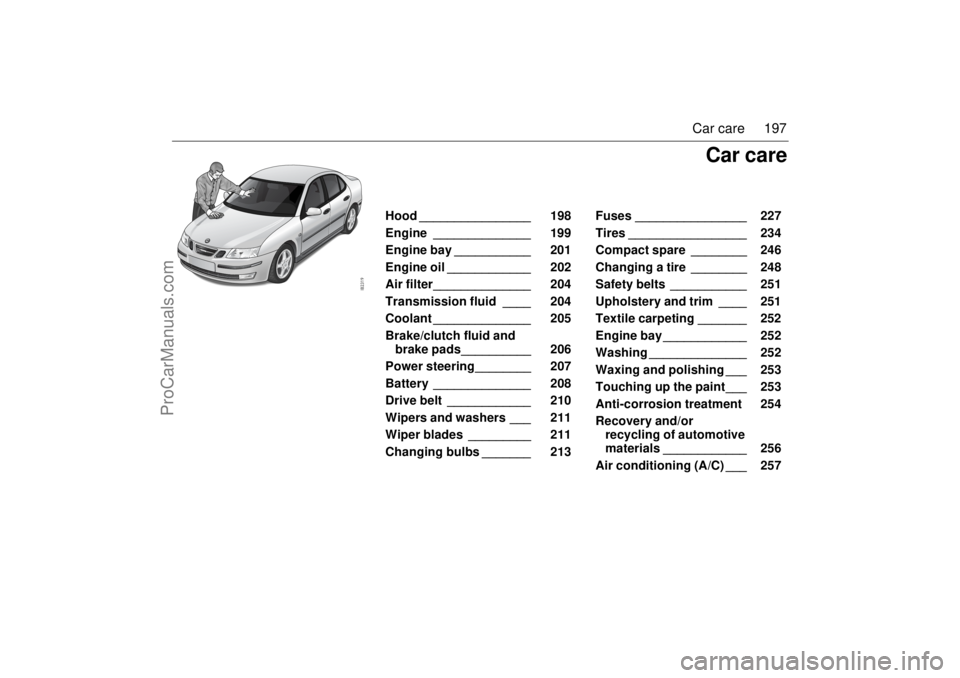
197 Car care
Hood ________________ 198
Engine ______________ 199
Engine bay ___________ 201
Engine oil ____________ 202
Air filter______________ 204
Transmission fluid ____ 204
Coolant ______________ 205
Brake/clutch fluid and
brake pads__________ 206
Power steering________ 207
Battery ______________ 208
Drive belt ____________ 210
Wipers and washers ___ 211
Wiper blades _________ 211
Changing bulbs _______ 213 Fuses ________________ 227
Tires _________________ 234
Compact spare ________ 246
Changing a tire ________ 248
Safety belts ___________ 251
Upholstery and trim ____ 251
Textile carpeting _______ 252
Engine bay ____________ 252
Washing ______________ 252
Waxing and polishing ___ 253
Touching up the paint___ 253
Anti-corrosion treatment 254
Recovery and/or
recycling of automotive
materials ____________ 256
Air conditioning (A/C) ___ 257
Car care
ProCarManuals.com
Page 202 of 292

200 Car careSaab Trionic engine
management systemThe Saab Trionic engine management
system is a unique Saab development that
combines sequential multiport fuel injection,
electronic distributorless ignition and turbo-
charger boost pressure control into one sys-
tem.
The Trionic engine control module (ECM)
monitors many different engine parameters
such as:
Intake manifold pressure.
Intake air temperature.
Crankshaft position.
Engine coolant temperature.
Throttle position.
The oxygen content of the exhaust gases.
The ECM receives information regarding
engine knocking from a sophisticated feed-
back function in the ignition discharge unit.
By processing all of this information, the Tri-
onic system can control fuel injector open-
ing duration, ignition timing and turbo-
charger boost pressure to provide excellent
engine performance while maintaining low
emissions and fuel consumption.
ORVR (Onboard Refueling Vapor
Recovery)All hydrocarbons formed when refueling will
be recovered by the car and not released
into the atmosphere. The hydrocarbons are
absorbed in an evaporative emission canis-
ter. When the engine is subsequently
started, the evaporative emission canister is
gradually purged as air is sucked into it
through a shut-off valve. The hydrocar-
bon/air mixture passes through the evap
canister purge valve and into the engine
where it is burned. “Refueling”, see
page 153.
When refueling, make sure you screw the
filler cap on and keep turning until it has
clicked 3 times.
NOTICEThe Trionic engine management system
continuously monitors the operation of
these systems and has on-board diag-
nostic capabilities (OBD II). If the Engine
malfunction (CHECK ENGINE) light in
the main instrument illuminates, the
Trionic ECM has detected a problem. The
car will continue to operate, but perfor-
mance may be diminished. You should
have your car checked by a Saab dealer
as soon as possible.
ProCarManuals.com
Page 203 of 292
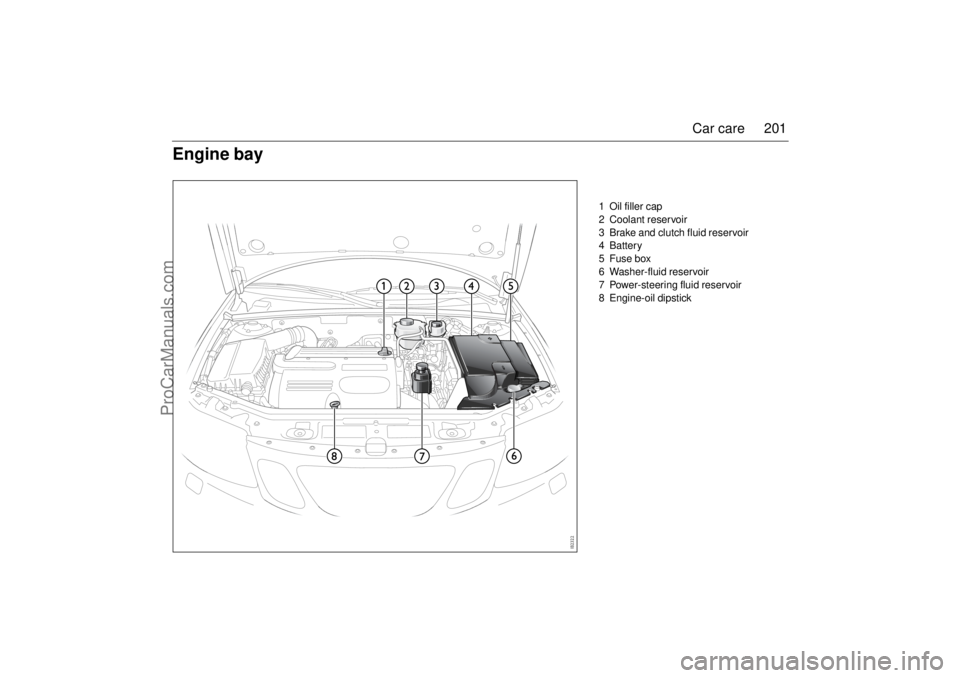
201 Car care
1 Oil filler cap
2 Coolant reservoir
3 Brake and clutch fluid reservoir
4Battery
5 Fuse box
6 Washer-fluid reservoir
7 Power-steering fluid reservoir
8 Engine-oil dipstick
Engine bay
ProCarManuals.com
Page 207 of 292
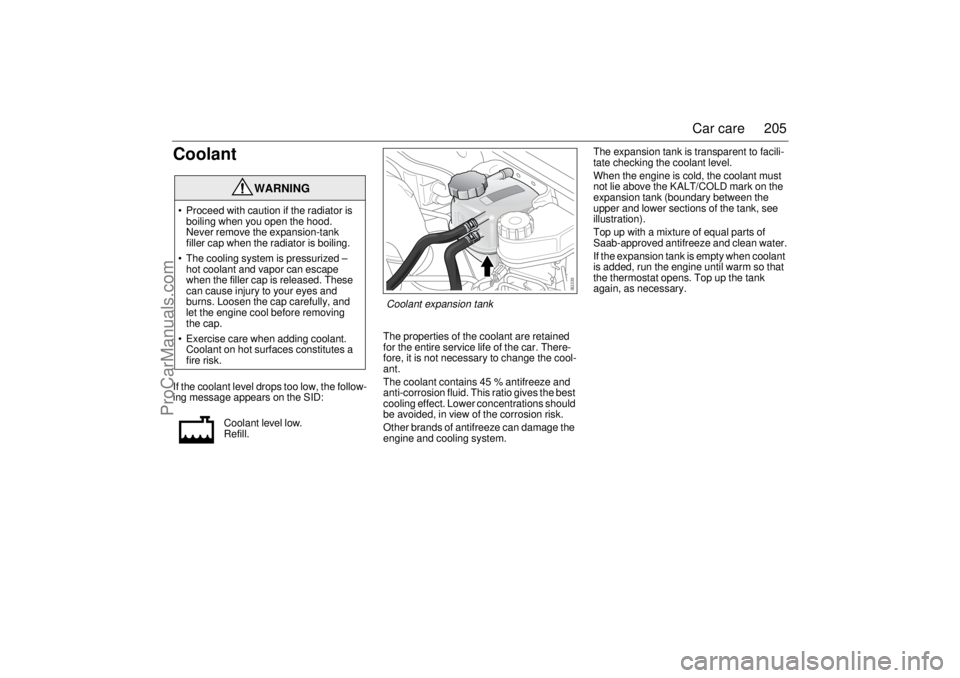
205 Car care
CoolantIf the coolant level drops too low, the follow-
ing message appears on the SID:The properties of the coolant are retained
for the entire service life of the car. There-
fore, it is not necessary to change the cool-
ant.
The coolant contains 45 % antifreeze and
anti-corrosion fluid. This ratio gives the best
cooling effect. Lower concentrations should
be avoided, in view of the corrosion risk.
Other brands of antifreeze can damage the
engine and cooling system.The expansion tank is transparent to facili-
tate checking the coolant level.
When the engine is cold, the coolant must
not lie above the KALT/COLD mark on the
expansion tank (boundary between the
upper and lower sections of the tank, see
illustration).
Top up with a mixture of equal parts of
Saab-approved antifreeze and clean water.
If the expansion tank is empty when coolant
is added, run the engine until warm so that
the thermostat opens. Top up the tank
again, as necessary.
WARNING
Proceed with caution if the radiator is
boiling when you open the hood.
Never remove the expansion-tank
filler cap when the radiator is boiling.
The cooling system is pressurized –
hot coolant and vapor can escape
when the filler cap is released. These
can cause injury to your eyes and
burns. Loosen the cap carefully, and
let the engine cool before removing
the cap.
Exercise care when adding coolant.
Coolant on hot surfaces constitutes a
fire risk.
Coolant level low.
Refill.
Coolant expansion tank
ProCarManuals.com
Page 208 of 292
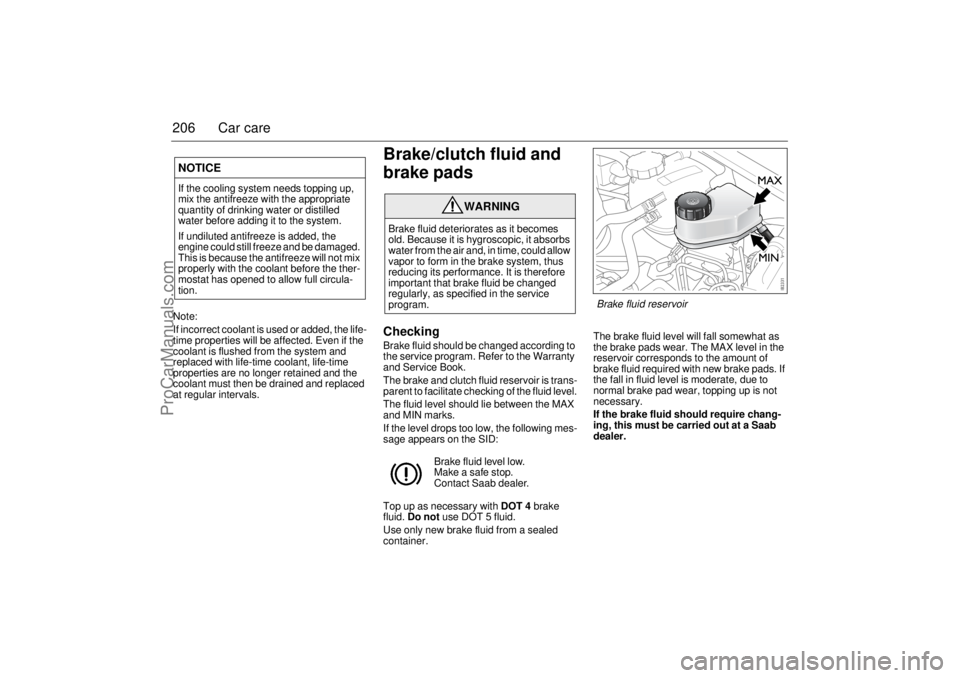
206 Car careNote:
If incorrect coolant is used or added, the life-
time properties will be affected. Even if the
coolant is flushed from the system and
replaced with life-time coolant, life-time
properties are no longer retained and the
coolant must then be drained and replaced
at regular intervals.
Brake/clutch fluid and
brake padsCheckingBrake fluid should be changed according to
the service program. Refer to the Warranty
and Service Book.
The brake and clutch fluid reservoir is trans-
parent to facilitate checking of the fluid level.
The fluid level should lie between the MAX
and MIN marks.
If the level drops too low, the following mes-
sage appears on the SID:
Top up as necessary with DOT 4 brake
fluid. Do not use DOT 5 fluid.
Use only new brake fluid from a sealed
container.The brake fluid level will fall somewhat as
the brake pads wear. The MAX level in the
reservoir corresponds to the amount of
brake fluid required with new brake pads. If
the fall in fluid level is moderate, due to
normal brake pad wear, topping up is not
necessary.
If the brake fluid should require chang-
ing, this must be carried out at a Saab
dealer.
NOTICEIf the cooling system needs topping up,
mix the antifreeze with the appropriate
quantity of drinking water or distilled
water before adding it to the system.
If undiluted antifreeze is added, the
engine could still freeze and be damaged.
This is because the antifreeze will not mix
properly with the coolant before the ther-
mostat has opened to allow full circula-
tion.
WARNING
Brake fluid deteriorates as it becomes
old. Because it is hygroscopic, it absorbs
water from the air and, in time, could allow
vapor to form in the brake system, thus
reducing its performance. It is therefore
important that brake fluid be changed
regularly, as specified in the service
program.
Brake fluid level low.
Make a safe stop.
Contact Saab dealer.
Brake fluid reservoir
ProCarManuals.com
Page 259 of 292
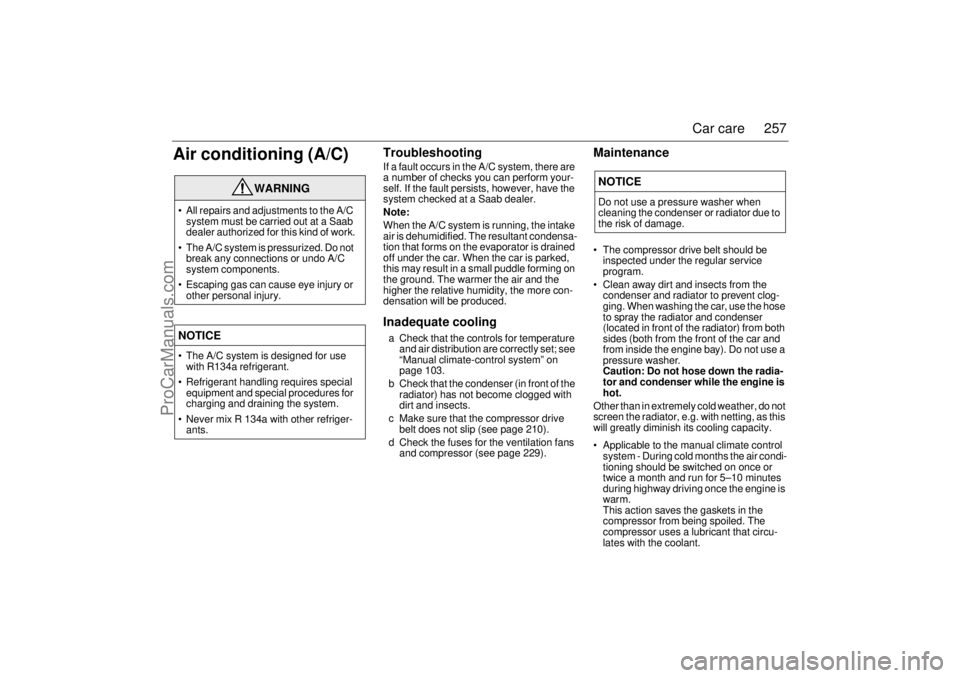
257 Car care
Air conditioning (A/C)
TroubleshootingIf a fault occurs in the A/C system, there are
a number of checks you can perform your-
self. If the fault persists, however, have the
system checked at a Saab dealer.
Note:
When the A/C system is running, the intake
air is dehumidified. The resultant condensa-
tion that forms on the evaporator is drained
off under the car. When the car is parked,
this may result in a small puddle forming on
the ground. The warmer the air and the
higher the relative humidity, the more con-
densation will be produced.Inadequate coolinga Check that the controls for temperature
and air distribution are correctly set; see
“Manual climate-control system” on
page 103.
b Check that the condenser (in front of the
radiator) has not become clogged with
dirt and insects.
c Make sure that the compressor drive
belt does not slip (see page 210).
d Check the fuses for the ventilation fans
and compressor (see page 229).
Maintenance The compressor drive belt should be
inspected under the regular service
program.
Clean away dirt and insects from the
condenser and radiator to prevent clog-
ging. When washing the car, use the hose
to spray the radiator and condenser
(located in front of the radiator) from both
sides (both from the front of the car and
from inside the engine bay). Do not use a
pressure washer.
Caution: Do not hose down the radia-
tor and condenser while the engine is
hot.
Other than in extremely cold weather, do not
screen the radiator, e.g. with netting, as this
will greatly diminish its cooling capacity.
Applicable to the manual climate control
system - During cold months the air condi-
tioning should be switched on once or
twice a month and run for 5–10 minutes
during highway driving once the engine is
warm.
This action saves the gaskets in the
compressor from being spoiled. The
compressor uses a lubricant that circu-
lates with the coolant.
WARNING
All repairs and adjustments to the A/C
system must be carried out at a Saab
dealer authorized for this kind of work.
The A/C system is pressurized. Do not
break any connections or undo A/C
system components.
Escaping gas can cause eye injury or
other personal injury.NOTICE The A/C system is designed for use
with R134a refrigerant.
Refrigerant handling requires special
equipment and special procedures for
charging and draining the system.
Never mix R 134a with other refriger-
ants.
NOTICEDo not use a pressure washer when
cleaning the condenser or radiator due to
the risk of damage.
ProCarManuals.com
Page 272 of 292

270 Technical dataEngine Engine oilType: Four cylinders,
double overhead
camshafts,
16 valves, two
balancer shafts
Cylinder bore____________________ 3.386'' (86 mm)
Stroke _________________________ 3.386'' (86 mm)
Swept volume ___________________ 122 cu.in. (1.998 l)
Idling speed_____________________ 720 rpm.
When the engine
load increases, e.g.
the steering wheel is
turned, the idling
speed is raised to
900 rpm.
Antifreeze ______________________ Saab-approved
antifreeze
Coolant capacity _________________ 7.5 qts. (7.1 l)To meet demands in Saab's extended service intervals all en-
gines are filled with specially designed synthetic factory fill oils.
Long service intervals, fuel economy and environmental issues
are the base for our choice of oil. By using oils approved by
Saab you minimise the tendencies for oil sludge build, by that
protecting the engine from harmful, wear increasing, deposits.
Approved oils:
All gasoline engines - Fully Synthetic Engine Oil fulfilling GM-
LL-A-025 requirements.
To ensure being able to take advantage of the Saab specified
service intervals, be sure to select a fully synthetic engine oil
fulfilling GM-LL-A-025 requirements.
Servicing/Oil changes:
To be able to use recommended service intervals the need to
use only approved engine oils is vital. Use only engine oils ap-
proved for your engine. Service should be done according to
the recommended service intervals to optimize your engine's
function through out its entire life. Saab Automobile AB will not
take responsibility for any damage that might occur due to ne-
glecting to meet above mentioned requirements.
At your Saab dealers you can find Saab Genuine or Mobil en-
gine oils. Among those there are oils specially designed to meet
your engines specific needs. We recommend that you, with the
help of our skilled service personnel, choose your oil from that
selection.
Other oil companies also have engine oils approved according
to GM specifications. Oils meeting these standards may be
identified as synthetic. However, not all synthetic oils will meet
your engines requirements. You should only use oil that meets
your engines specific requirements (GM-LL-A-025).
ProCarManuals.com
Page 283 of 292
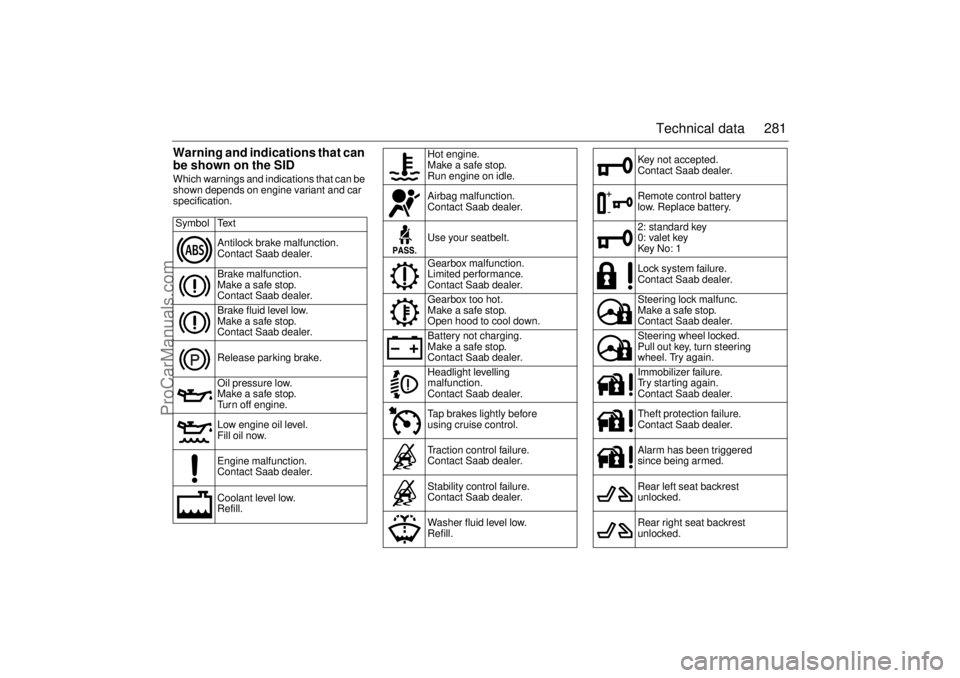
281 Technical data
Warning and indications that can
be shown on the SIDWhich warnings and indications that can be
shown depends on engine variant and car
specification.
Symbol Text
Antilock brake malfunction.
Contact Saab dealer.
Brake malfunction.
Make a safe stop.
Contact Saab dealer.
Brake fluid level low.
Make a safe stop.
Contact Saab dealer.
Release parking brake.
Oil pressure low.
Make a safe stop.
Turn off engine.
Low engine oil level.
Fill oil now.
Engine malfunction.
Contact Saab dealer.
Coolant level low.
Refill.
Hot engine.
Make a safe stop.
Run engine on idle.
Airbag malfunction.
Contact Saab dealer.
Use your seatbelt.
Gearbox malfunction.
Limited performance.
Contact Saab dealer.
Gearbox too hot.
Make a safe stop.
Open hood to cool down.
Battery not charging.
Make a safe stop.
Contact Saab dealer.
Headlight levelling
malfunction.
Contact Saab dealer.
Tap brakes lightly before
using cruise control.
Traction control failure.
Contact Saab dealer.
Stability control failure.
Contact Saab dealer.
Washer fluid level low.
Refill.
Key not accepted.
Contact Saab dealer.
Remote control battery
low. Replace battery.
2: standard key
0: valet key
Key No: 1
Lock system failure.
Contact Saab dealer.
Steering lock malfunc.
Make a safe stop.
Contact Saab dealer.
Steering wheel locked.
Pull out key, turn steering
wheel. Try again.
Immobilizer failure.
Try starting again.
Contact Saab dealer.
Theft protection failure.
Contact Saab dealer.
Alarm has been triggered
since being armed.
Rear left seat backrest
unlocked.
Rear right seat backrest
unlocked.
ProCarManuals.com
Page 285 of 292

283 Index
Index
AA/C
__________________________ 106
ABS brakes
____________________ 167
ACC
_________________________ 108
Adjustment, steering wheel
________ 122
Air conditioning
_________________ 106
Air filter
_______________________ 204
Airbag
_________________________ 29
Anchorage eyes
________________ 143
Anti-corrosion treatment
__________ 254
Antilock braking system __________ 167
Anti-spin
______________________ 169
Ashtrays ______________________ 132
Autochecking of lights, warning and
indicator lights
__________________ 82
Autodimming
_______________ 135
, 136
Automatic climate control (ACC)
____ 108
Automatic transmission
___________ 159
BBattery
________________________ 208
Bedding-in of new brake pads
_____ 157
Before towing a trailer
____________ 187
Brake fluid, grade
_______________ 274
Brakes
________________________ 166Braking
_______________________ 166
Bulb changing
__________________ 213
Bulb table
_____________________ 226
Buying new tires
________________ 236
CCabin lighting
__________________ 129
Cabin lighting, Convertible
_________ 72
Car alarm
______________________ 50
Car transport ___________________ 192
Care of air conditioning
___________ 257
Change of address notification
_____ 264
Changing a tire
_________________ 248
Changing bulbs _________________ 213
Changing engine oil
_____________ 203
Changing the battery, remote control
_48
Changing wiper blades
___________ 211
Checking the number of remote
controls
_______________________ 47
Checks before towing a trailer
______ 187
Child safety
_____________________ 22
Child safety locks, rear doors
_______ 46
Child seats
_____________________ 22
Cigarette lighter
_________________ 132
Cleaning the engine bay
__________ 252
Cleaning upholstery
_____________ 251
Climate control system, manual
____ 103
Closing the soft top manually,
Convertible
____________________ 62
Closing the soft top, Convertible
_____ 58Clutch interlock
_________________ 158
Compact spare _________________ 246
Compass
______________________ 139
Condensation water, A/C
_________ 106
Convertible
_____________________ 55
Convertible, washing
_____________ 253
Coolant
_______________________ 205
Crash memory, see EDR
_________ 266
Cruise control
__________________ 165
Cup holder
_____________________ 130
DDate codes, tires
________________ 246
Deep water, driving through
_______ 189
Definitions and terminology, tire ____ 243
Determining correct load, tires
_____ 245
Direction indicator stalk switch ______ 98
Direction indicators
_______________ 98
Dome light, Convertible
___________ 223
Dome light, Sport Sedan __________ 222
Donor battery, boost starting
_______ 193
Door handles
____________________ 42
Door mirrors ___________________ 134
Drive belt
______________________ 210
Drive belt, length
________________ 272
Driver’s seat with memory
__________ 20
Driving at night
_________________ 190
Driving in cold climates
___________ 181
Driving in deep water
_____________ 189
Driving in hot climates ____________ 183
ProCarManuals.com
Page 291 of 292
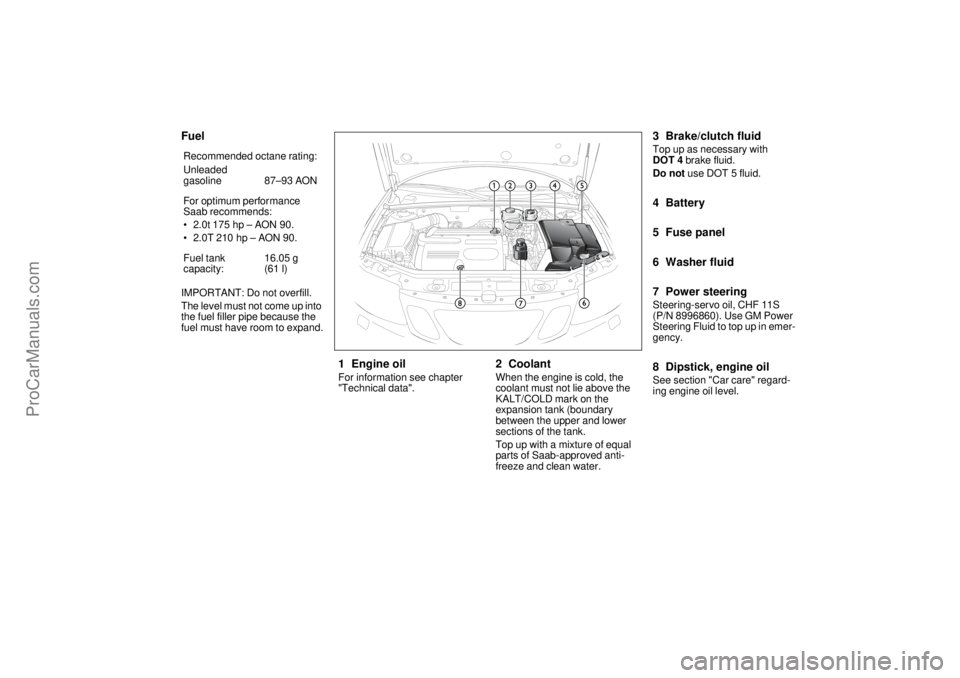
FuelIMPORTANT: Do not overfill.
The level must not come up into
the fuel filler pipe because the
fuel must have room to expand.
1 Engine oilFor information see chapter
"Technical data".
2 CoolantWhen the engine is cold, the
coolant must not lie above the
KALT/COLD mark on the
expansion tank (boundary
between the upper and lower
sections of the tank.
Top up with a mixture of equal
parts of Saab-approved anti-
freeze and clean water.
3 Brake/clutch fluidTop up as necessary with
DOT 4 brake fluid.
Do not use DOT 5 fluid.4Battery
5 Fuse panel
6 Washer fluid
7 Power steeringSteering-ser vo oil, CHF 11S
(P/N 8996860). Use GM Power
Steering Fluid to top up in emer-
gency.8 Dipstick, engine oilSee section "Car care" regard-
ing engine oil level. Recommended octane rating:
Unleaded
gasoline 87–93 AON
For optimum performance
Saab recommends:
2.0t 175 hp – AON 90.
2.0T 210 hp – AON 90.
Fuel tank
capacity:16.05 g
(61 l)
ProCarManuals.com